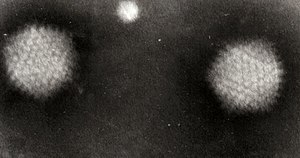Adenovirus gastroenteritis
| Adenovirus gastroenteritis | |
|---|---|
 | |
| Specialty | Infectious diseases |
| Symptoms | Fever, vomiting, diarrhea[1] |
| Complications | Dehydration, colitis, pancreatitis, hepatitis[2] |
| Usual onset | Sudden[1] |
| Causes | Adenoviridae types 40/41 (species F) and others[1] |
| Risk factors | Very young children[1] |
| Prevention | Improved water quality, sanitation, hygiene[1] |
| Treatment | Fluid replacement[1] |
| Frequency | Under one-year olds in LMIC, around 75 million episodes in <5-year olds (2016)[1] |
Adenovirus gastroenteritis is a diarrhea illness, a type of adenovirus infection caused by certain types of Adenoviruses.[1] It generally presents with fever, vomiting, and diarrhea.[1] Sometimes there are symptoms of a respiratory tract infection.[1] Symptoms typically persist for 8-12 days.[3]
It is caused typically by types 40/41 (species F) of the virus Adenoviridae.[2] Other adenoviruses associated with gastroenteritis include types G52 and some members from the D species.[2] Depending on the type, there may or may not be an associated respiratory tract infection.[1] Spread is generally via the fecal-oral route.[1] The most common complication is dehydration.[2]
Treatment is supportive, with replacing lost fluids by mouth and injection, zinc supplementation, and adequate nutrition.[1] Most cases get better without any specific treatment.[2] Prevention requires improved water quality, sanitation, and hygiene.[1]
It is a common cause of diarrhea globally.[4] Up to 10% of diarrhea in children are caused by adenoviruses.[3] In 2016, the Global Burden of Disease Study estimated that globally, around 75 million episodes of diarrhea among children under the age of five-years, were attributable to adenovirus infection, particularly in low and middle income countries.[1]
Signs and symptoms
Adenovirus gastroenteritis generally presents with fever, vomiting, and diarrhea.[1] Depending on the type, there may or may not be an associated respiratory tract infection.[1] Symptoms typically persist for 8-12 days.[3]
Cause and mechanism
Although other types may be implicated, generally types 40/41 (species F) of the virus Adenoviridae has been established as a cause of severe diarrhoea in very young children in low and middle income countries.[1] Other adenoviruses associated with gastroenteritis include types G52 and some members from the D species.[2] Adenoviruses -12, -18, and -31 infection have also been implicated as causes of gastroenteritis.[5] Spread is generally via the fecal-oral route.[1]
Complications include chiefly dehydration, and infrequently colitis, pancreatitis and hepatitis.[2]
Treatment and prevention
Treatment is supportive, with replacing lost fluids by mouth and injection, zinc supplementation, and adequate nutrition.[1] Most cases get better without any specific treatment.[2] Prevention requires improved water quality, sanitation, and hygiene.[1]
Epidemiology
It is a common cause of diarrhea globally, along with rotavirus, norovirus and astrovirus.[4] Up to 10% of diarrhea in children are caused by adenoviruses.[3] It affects particularly under one-year olds, but the numbers affected vary significantly year by year.[1] The exact number of people affected is not known; reliable rapid testing is not widely available.[1] It is a frequent cause of hospital admissions.[1] In 2016, the Global Burden of Disease Study estimated that globally, around 75 million episodes of diarrhea among children under the age of five-years, were attributable to adenovirus infection, with a mortality of near 12%.[1]
History
Adenoviruses type F40/41 were first detected in 1983 by de Jong and Unhoo.[2]
References
- ↑ 1.00 1.01 1.02 1.03 1.04 1.05 1.06 1.07 1.08 1.09 1.10 1.11 1.12 1.13 1.14 1.15 1.16 1.17 1.18 1.19 1.20 1.21 1.22 1.23 1.24 Lee, B; Damon, CF; Platts-Mills, JA (October 2020). "Pediatric acute gastroenteritis associated with adenovirus 40/41 in low-income and middle-income countries". Current opinion in infectious diseases. 33 (5): 398–403. doi:10.1097/QCO.0000000000000663. PMID 32773498. Archived from the original on 2022-04-18. Retrieved 2022-05-05.
- ↑ 2.0 2.1 2.2 2.3 2.4 2.5 2.6 2.7 2.8 Flint, S. Jane; Nemerow, Glen R. (2017). "8. Pathogenesis". Human Adenoviruses: From Villains To Vectors. Singapore: World Scientific. p. 161. ISBN 978-981-310-979-7. Archived from the original on 2022-05-06. Retrieved 2022-05-06.
- ↑ 3.0 3.1 3.2 3.3 Ison, Michael G. (2019). "341. Adenovirus diseases". In Goldman, Lee; Schafer, Andrew I. (eds.). Goldman-Cecil Medicine (26th ed.). Elsevier. p. 2163. ISBN 978-0-323-55087-1. Archived from the original on 2022-04-28. Retrieved 2022-04-27.
- ↑ 4.0 4.1 Barlow, Gavin; Irving, William L.; Moss, Peter J. (2020). "20. Infectious disease". In Feather, Adam; Randall, David; Waterhouse, Mona (eds.). Kumar and Clark's Clinical Medicine (10th ed.). Elsevier. pp. 529–530. ISBN 978-0-7020-7870-5. Archived from the original on 2022-05-06. Retrieved 2022-05-06.
- ↑ Lynch, Joseph P.; Kajon, Adriana E. (August 2016). "Adenovirus: Epidemiology, Global Spread of Novel Serotypes, and Advances in Treatment and Prevention". Seminars in Respiratory and Critical Care Medicine. 37 (4): 586–602. doi:10.1055/s-0036-1584923. ISSN 1098-9048. PMID 27486739. Archived from the original on 2022-04-08. Retrieved 2022-05-07.
External links
| Classification |
|---|